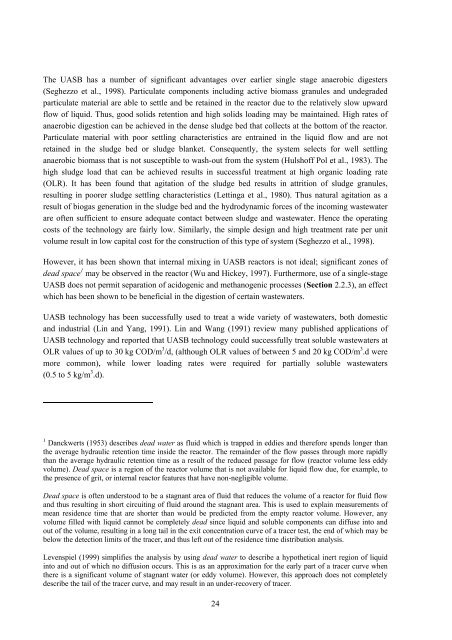analysis of a pilot-scale anaerobic baffled reactor treating domestic ...
analysis of a pilot-scale anaerobic baffled reactor treating domestic ...
analysis of a pilot-scale anaerobic baffled reactor treating domestic ...
You also want an ePaper? Increase the reach of your titles
YUMPU automatically turns print PDFs into web optimized ePapers that Google loves.
The UASB has a number <strong>of</strong> significant advantages over earlier single stage <strong>anaerobic</strong> digesters<br />
(Seghezzo et al., 1998). Particulate components including active biomass granules and undegraded<br />
particulate material are able to settle and be retained in the <strong>reactor</strong> due to the relatively slow upward<br />
flow <strong>of</strong> liquid. Thus, good solids retention and high solids loading may be maintained. High rates <strong>of</strong><br />
<strong>anaerobic</strong> digestion can be achieved in the dense sludge bed that collects at the bottom <strong>of</strong> the <strong>reactor</strong>.<br />
Particulate material with poor settling characteristics are entrained in the liquid flow and are not<br />
retained in the sludge bed or sludge blanket. Consequently, the system selects for well settling<br />
<strong>anaerobic</strong> biomass that is not susceptible to wash-out from the system (Hulsh<strong>of</strong>f Pol et al., 1983). The<br />
high sludge load that can be achieved results in successful treatment at high organic loading rate<br />
(OLR). It has been found that agitation <strong>of</strong> the sludge bed results in attrition <strong>of</strong> sludge granules,<br />
resulting in poorer sludge settling characteristics (Lettinga et al., 1980). Thus natural agitation as a<br />
result <strong>of</strong> biogas generation in the sludge bed and the hydrodynamic forces <strong>of</strong> the incoming wastewater<br />
are <strong>of</strong>ten sufficient to ensure adequate contact between sludge and wastewater. Hence the operating<br />
costs <strong>of</strong> the technology are fairly low. Similarly, the simple design and high treatment rate per unit<br />
volume result in low capital cost for the construction <strong>of</strong> this type <strong>of</strong> system (Seghezzo et al., 1998).<br />
However, it has been shown that internal mixing in UASB <strong>reactor</strong>s is not ideal; significant zones <strong>of</strong><br />
dead space 1 may be observed in the <strong>reactor</strong> (Wu and Hickey, 1997). Furthermore, use <strong>of</strong> a single-stage<br />
UASB does not permit separation <strong>of</strong> acidogenic and methanogenic processes (Section 2.2.3), an effect<br />
which has been shown to be beneficial in the digestion <strong>of</strong> certain wastewaters.<br />
UASB technology has been successfully used to treat a wide variety <strong>of</strong> wastewaters, both <strong>domestic</strong><br />
and industrial (Lin and Yang, 1991). Lin and Wang (1991) review many published applications <strong>of</strong><br />
UASB technology and reported that UASB technology could successfully treat soluble wastewaters at<br />
OLR values <strong>of</strong> up to 30 kg COD/m 3 /d, (although OLR values <strong>of</strong> between 5 and 20 kg COD/m 3 .d were<br />
more common), while lower loading rates were required for partially soluble wastewaters<br />
(0.5 to 5 kg/m 3 .d).<br />
1 Danckwerts (1953) describes dead water as fluid which is trapped in eddies and therefore spends longer than<br />
the average hydraulic retention time inside the <strong>reactor</strong>. The remainder <strong>of</strong> the flow passes through more rapidly<br />
than the average hydraulic retention time as a result <strong>of</strong> the reduced passage for flow (<strong>reactor</strong> volume less eddy<br />
volume). Dead space is a region <strong>of</strong> the <strong>reactor</strong> volume that is not available for liquid flow due, for example, to<br />
the presence <strong>of</strong> grit, or internal <strong>reactor</strong> features that have non-negligible volume.<br />
Dead space is <strong>of</strong>ten understood to be a stagnant area <strong>of</strong> fluid that reduces the volume <strong>of</strong> a <strong>reactor</strong> for fluid flow<br />
and thus resulting in short circuiting <strong>of</strong> fluid around the stagnant area. This is used to explain measurements <strong>of</strong><br />
mean residence time that are shorter than would be predicted from the empty <strong>reactor</strong> volume. However, any<br />
volume filled with liquid cannot be completely dead since liquid and soluble components can diffuse into and<br />
out <strong>of</strong> the volume, resulting in a long tail in the exit concentration curve <strong>of</strong> a tracer test, the end <strong>of</strong> which may be<br />
below the detection limits <strong>of</strong> the tracer, and thus left out <strong>of</strong> the residence time distribution <strong>analysis</strong>.<br />
Levenspiel (1999) simplifies the <strong>analysis</strong> by using dead water to describe a hypothetical inert region <strong>of</strong> liquid<br />
into and out <strong>of</strong> which no diffusion occurs. This is as an approximation for the early part <strong>of</strong> a tracer curve when<br />
there is a significant volume <strong>of</strong> stagnant water (or eddy volume). However, this approach does not completely<br />
describe the tail <strong>of</strong> the tracer curve, and may result in an under-recovery <strong>of</strong> tracer.<br />
24
















